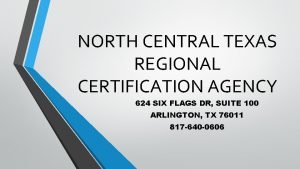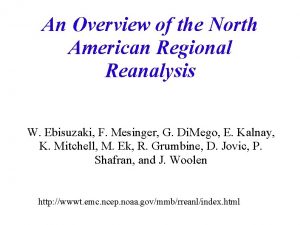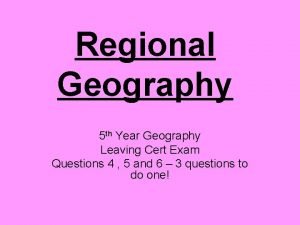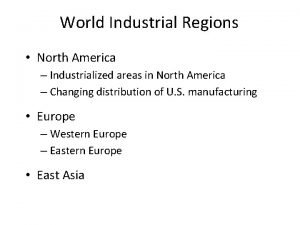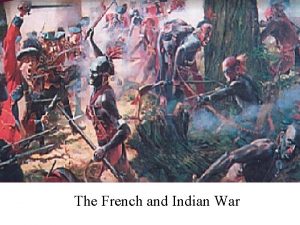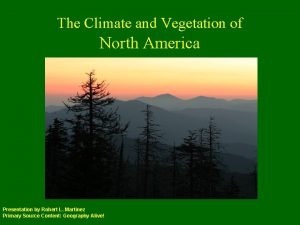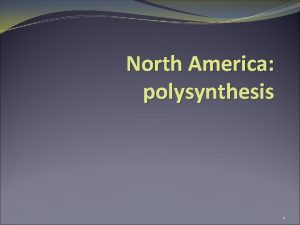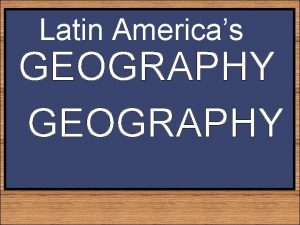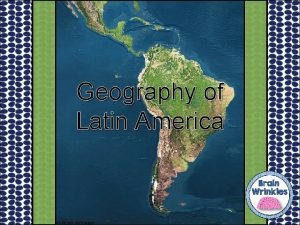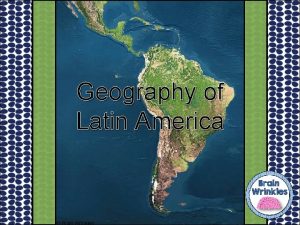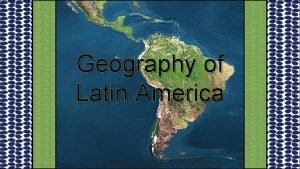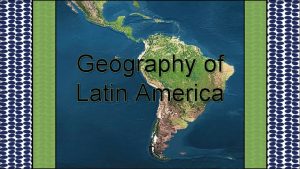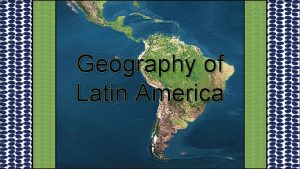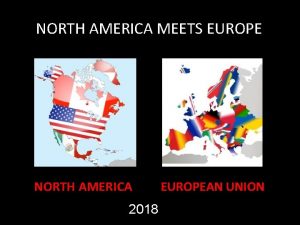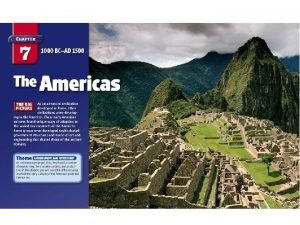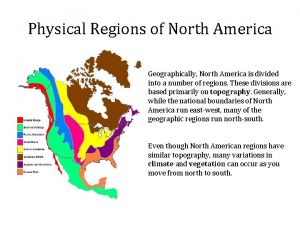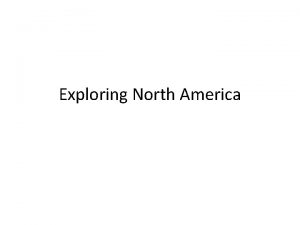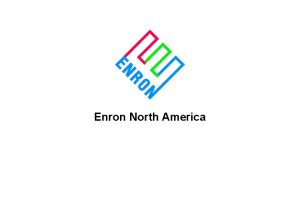REGIONAL GEOGRAPHY OF NORTH AMERICA Pages 160 180














- Slides: 14

REGIONAL GEOGRAPHY OF NORTH AMERICA Pages 160 -180 in your text book

DEFINITIONS • Region – area with similar characteristics • Tectonic – to do with the structure of Earth’s crust • Fold mountains – created by bending of rock layers • Volcanic mountains – created by breaks in the Earth’s crust • Erode – to wear down the surface of the Earth • Glaciation – land covered with thick, moving ice • Vegetation – plants that grow naturally in an area • Topography – the shape of the land • Climate – conditions of temperature and precipitation over the long-term

EARTH HISTORY • How old is the Earth? – 4. 5 billion years • 3 layers of the Earth 1. Crust – thin layer of rock (5 -35 km thick); large and small sections called plates 2. Mantle – molten rock (magma) moves like water and causes plates to move 3. Core – hot, dense mass (solid in the middle); intense heat responsible for keeping mantle liquid • When did North America form? – 600 to 225 million years ago • Fold mountain examples – Rocky and Appalachian • Volcanic mountain examples – Canadian Shield and Coastal Ranges • Ice age effects • Southern prairies – Lake Agassiz formed; layers of silt laid down, drained and left broad, flat land • Canadian shield – retreating glaciers scraped the rocks bare leaving only a thin layer of soil

APPALACHIAN REGION - OVERVIEW • Four Canadian provinces: Newfoundland, Nova Scotia, New Brunswick, PEI • Five US States: Alabama, Maine, New York, Virginia, Vermont • Appalachian mountains formed 300 000 years ago • They are fold mountains caused by two plates coming together • Climate influence – 2 ocean currents (gulf stream and Labrador currents) • Barrier to colonization? – rugged nature of landscape and dense forests make it difficult to cross the Appalachian mountains

APPALACHIAN REGION - CHART • Types of terrain - mountains, fertile plateaus, river valleys • Minerals present – coal, oil, gas • Vegetation present – mixed coniferous and deciduous trees

COASTAL PLAINS - OVERVIEW • 5 US states – Florida, Louisiana, Alaska, New Jersey, Maryland, Rhode Island, Mississippi • How far inland do they extend? - 50 to 100 km • Average elevation – less than 200 m above sea level (more than half less than 30 m) • With respect to climate, why is Florida an important tourist centre? – very warm with little precipitation during winter months

COASTAL PLAINS CHART • Types of terrain – coastal plains, swamps, marshes, river deltas • Vegetation present – fertile agricultural land, lush jungles, pine forests

APPALACHIAN VS. COASTAL PLAINS • Differences between regions? • Flatness • Low elevations • Low precipitation levels • Swamps and marshes • Similarities between regions? • Difference in temperature between north and south • Natural vegetation that includes forests

GREAT LAKES/ ST. LAWRENCE LOWLAND - OVERVIEW • Escarpment – steep cliff formed by erosion or faulting • Rift valley – created when land between 2 faults drop down • What great lakes surround this region? – Lakes Huron, Ontario and Erie • How do the lakes affect the climate? – humid, cool temperatures in summer, keeps warm in winter ***climate control • Favourable for agriculture because of fertile soil and long growing season • Why is it the most populous region in Canada? – moderate climate, fertile soil (good growing), lakes/ river – transportation, rolling landscape = less barriers

GREAT LAKES/ ST. LAWRENCE CHART • Types of terrain – rolling landscape, flat plains, hills, deep river valleys • Vegetation present – originally very fertile and heavily treed, once largest broad leaf forest in North America, • Tree types: maple, beech, hickory, black walnut, oak, ash, birch, spruce, fir, pine cedar

INTERIOR PLAINS - OVERVIEW • 4 provinces/ territories – NWT, BC, AB, Sask, Manitoba • 5 US States - Montana, N. Dakota, Minnesota, Missouri, Iowa, Texas • Mountain ranges surrounding in US – Rockies and Appalachians • Mountain ranges surrounding in Canada – Rockies and Canadian shield • Why so much diversity? – huge size/ vastness

INTERIOR PLAINS - CHART • Types of terrain – plains, gently rolling hills, deep river valleys, mountains, great lakes • Vegetation present – mixed deciduous trees, scattered evergreens, prairie grasses, grasslands, boreal forests, tundra

CANADIAN SHIELD - OVERVIEW • Muskeg – level bog or swamp in Canada • Boreal – northern or of ”The Arctic” • Effects of glaciation? – removed natural cover (vegetation and soil), glacial debris altered natural drainage • Mineral storehouse – deposits of lead, copper, gold, zinc and nickle • Important industries? – forestry, mining ***hydro power

CANADIAN SHIELD - CHART • Types of terrain – bare rock, rivers, lakes, swamps, muskeg • Vegetation present – spruce, pine, fir, poplar, white birch • Minerals present – lead, copper, gold, zinc and nickle
 Printed pages vs web pages
Printed pages vs web pages North america south america asia europe africa
North america south america asia europe africa 100+120+140+160+180
100+120+140+160+180 Nctrca application
Nctrca application North american regional reanalysis
North american regional reanalysis Mezzogiorno map leaving cert
Mezzogiorno map leaving cert Pres wexford geography
Pres wexford geography America america you mean the world to me
America america you mean the world to me Whats an onomatopeia
Whats an onomatopeia Why is latin america called latin america
Why is latin america called latin america Performance e body art
Performance e body art Eastern north america industrial region
Eastern north america industrial region Air mass source regions
Air mass source regions French territory in north america 1754
French territory in north america 1754 Vegetation of north america
Vegetation of north america



